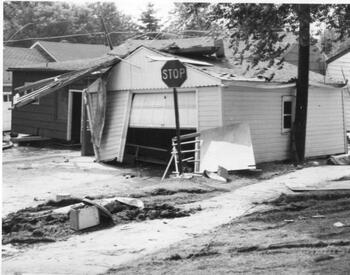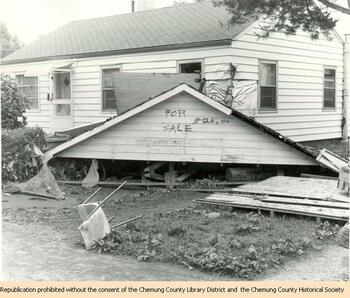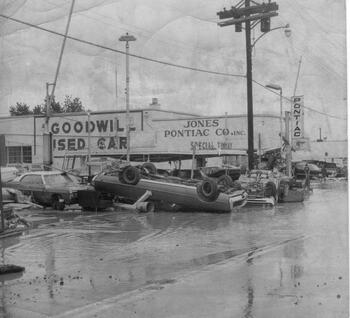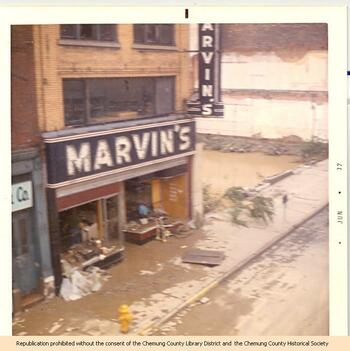Throughout the Southern Tier, floodwaters receded on June 24, but mud and waterlogged belongings were just the beginning of the problems facing residents. The force of the raging water had broken windows, flipped cars, deposited detritus everywhere, and caused massive structural damage to hundreds of buildings. Some houses had collapsed, while others had been lifted off their foundations and dropped into their own basements. Some had been swept away entirely.
Flood insurance was rare at the time, and most of the affected homes and businesses lacked it. In addition to the damage to private property, the damage to commercial and manufacturing space put thousands of people out of work, adding to the economic devastation of the flood.
Beginning Thursday, June 22 when the flooding began, power was out for most of the region, as well as telephone lines, gas service, and clean water. Banks were slow to fully reopen open, since their own buildings, offices, records, and employees were affected. Federal agencies like the Small Business Administration arrived on scene to help business owners and residents begin applying for disaster loans.
Severely damaged garage on a wreckage-strewn yard. Courtesy of the Corning-Painted Post Historical Society and the Steuben County Historical Society.
In Corning, a tree (on the right) appears to have stopped two garages from drifting any farther.
House off its foundation [1972]. Courtesy of the Chemung County Historical Society and the Steele Memorial Library.
In Elmira, a house's roof migrated to a neighbor's lawn, where someone wrote "For sale $25.00" on the front.
Jones' Pontiac Dealership on Centerway. Courtesy of Steuben County Historical Society.
This business was located on Centerway in Corning, near the Corning Museum of Glass. The flipped and displaced cars show the force that the flood water had delivered. Businesses around the Southern Tier struggled to recover after the flooding, as their stock, facilities, supply chain, and employees all suffered.
A contemporary article in the New York Times quoted a local businessman who owned Cortright Printers, a print shop in Corning. He had a customer list of one hundred businesses, and only four of them were unaffected by the flood. His own printery was destroyed in the flood, as was his car and house.
Marvin's clothing store [1972]. Courtesy of the Chemung County Historical Society and the Steele Memorial Library.
Debris piled up in front of Marvin's clothing store in downtown Elmira, showing the destruction.
The National Guard stood on the corners of cities like Elmira to prevent the possibility of looting, although anything not immediately destroyed by the flood was left covered in thick flood mud.
StoryCorps Oral History Interview with Jerry Nykiel. Courtesy of the Southeast Steuben County Library.
In this 2009 StoryCorps interview, Jerry Nykiel recounts his different jobs, working for the City of Elmira during the cleanup of the summer of 1972. He describes cleaning out supermarkets, abandoned by their owners, that had been full of rancid meat in broken coolers after more than a week of no power in July heat.



